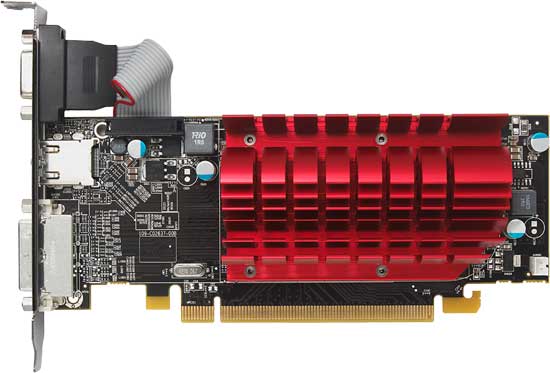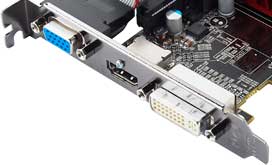AMD’s Radeon HD 5450: The Next Step In HTPC Video Cards
by Ryan Smith on February 4, 2010 12:00 AM EST- Posted in
- GPUs
Meet the 5450
As luck would have it, we ran in to a bit of a snafu yesterday morning when wrapping up our test of the 5450. As we stated in our intro, the DDR3 Radeon 5450 is supposed to be clocked at 650MHz core and 800MHz memory, but that’s not what we got. Internally AMD has been sampling a 650MHz/900MHz card for one of the OEMs they work with, and a few of those samples made it out with the 650MHz/800MHz review samples for the press. As one of the (un)lucky winners, we received a 650MHz/900MHz sample, meaning our card isn’t quite a reference card. Thankfully we have more than one 5450 and we were able to benchmark a stock-clocked Sapphire card, but keep in mind a proper built-to-reference card is going to be equipped with slightly different RAM than our sample is. Besides the RAM chips, everything else about our sample is the same as a reference card.

With that out of the way, the 5450 is intended to be a replacement for both the Radeon 4350 and the Radeon 4550. The former was AMD’s previous low-profile card, while the latter was the DDR3 equipped version. Thus we have something similar in size and power usage as the 4350, but packing the “complete” abilities of the chip like 4550.
The 5450 AMD is sampling is the 512MB DDR3 version, for which the reference clocks are 650MHz core, 800MHz (1600MHz data rate) memory, and a 64bit bus giving it 12.8GB/sec of memory bandwidth. There will also be 5450s released using DDR2 (which unfortunately will share the 5450 name), and AMD tells us that vendors have the option of equipping their cards with either 512MB or 1GB of memory. So we’re potentially going to see 4 different 5450 configurations, with the possibility of 1-2 more if any vendors go ahead and build 900MHz DDR3 cards for public purchase.
The reference 5450 is a low-profile card, measuring 6.61” long (the same as the 5670). The low 19.1 TDP means that it can be passively cooled, and as such AMD has equipped it with a double-wide heatsink. This differs slightly from the 4350, where the reference card was actively cooled and the vendor cards were almost entirely passively cooled. There is a 2pin fan header near the back of the card to allow active cooling, but we aren’t immediately expecting anyone to go that route.
The card is equipped with 4 Samsung DDR3 900MHz RAM chips, 2 on the front and 2 on the rear. Note that the 900MHz RAM chips are an artifact due to the fact that this is the wrong sample card. A regular DDR3 5450 such as our Sapphire card would be equipped with 800MHz RAM chips instead.
Anyone hoping to push a bit more out of the 5450 is going to find themselves disappointed when it comes to pure reference cards. AMD has disabled Overdrive by default on these cards, leaving it up to the card vendor to decide if they want to offer it or not.

Finally, since the 5450 is a low-profile card, we have yet another variant in the port configuration. Our sample card is equipped with 1 DVI port and 1 DisplayPort directly on the card, and a VGA port on the bracket attached to the card via cable. The 5450 – like all other 5000-series cards – supports 3-monitor Eyefinity, so all 3 ports can be used at once, although the VGA port is obviously going to make it less desirable here.
We should note that only cards with a DisplayPort will support Eyefinity, which means that if a vendor decides to equip the card with an HDMI port instead, they have to give up Eyefinity to do so. We expect to see some cards with HDMI for the HTPC crowd, but at this point we don’t have any idea as to how many there will be. DVI-to-HDMI adaptors still work here, so we may see vendors spend a bit more money and go that route instead.










77 Comments
View All Comments
Lifted - Thursday, February 4, 2010 - link
The first graph on each of the benchmark pages lists a 5670, the second graph lists a 4670. Typo or are you actually using different cards?Ryan Smith - Thursday, February 4, 2010 - link
It's not a typo. We never ran the 5670 at 1024x768, there was no reason to. It's more than fast enough for at least 1280.The 4670 data is from the GT 240 review, which we used 1024 on (because GT 240 couldn't cut the mustard above 1024 at times).
8steve8 - Thursday, February 4, 2010 - link
should have had the clarkdale igp in there for good measure, if you aren't gaming I'd guess that igp would be the way to goMrSpadge - Thursday, February 4, 2010 - link
Would have been interesting to compare idle power consumption: Clarkie + IGP vs. Clarkie + 5450.Ryan Smith - Thursday, February 4, 2010 - link
Testing a Clarkie requires switching out our test rig, so the results wouldn't be directly comparable since it means switching out everything including the processor. Plus Anand we only have a couple of Clarkies, which are currently in use for other projects.At this point Clarkie (and any other IGP) is still less than half as fast as 5450.
strikeback03 - Thursday, February 4, 2010 - link
That brings up the point though that with a card this low on the totem pole it might be nice to include a benchmark or two of it paired with similarly low-priced hardware. I understand the reason for generally using the same testbed, but when it is already borderline playable it would be nice to know that it won't get any slower when actually paired with a cheap processor and motherboard.Ryan Smith - Thursday, February 4, 2010 - link
Testing a Clarkie requires switching out our test rig, so the results wouldn't be directly comparable since it means switching out everything including the processor.At this point Clarkie (and any other IGP) is still less than half as fast as 5450.
kevinqian - Thursday, February 4, 2010 - link
Hey Ryan, I'm glad you are the first reviewer to utilize Blaubart's very helpful deinterlacing benchmark. I would just like to note that with ATI, it seems memory bandwidth plays a big part in deinterlacing method as well. For example, the HD 4650 DDR2 can only perform MA deinterlacing, even tho it has the same shaders as the (VA capable) 4670. The only bottleneck there seems to be the DDR2 memory bandwidth. On the other hand, with the HD 4550, though it has DDR3, it is limited to 64bit memory interface, so that seems to be a limiting factor.I have an old HD 2600Pro DDR2 AGP. When I OC the memory from 800mhz stock to 1000mhz, VA gets activated by CCC and confirmed in Cheese slices.
Nvidia's deinterlacing algorithm seem to be less memory intensive as even the GT220 with DDR2 is able to perform VA-like deinterlacing.
Ryan Smith - Thursday, February 4, 2010 - link
Yeah, I've seen the bandwidth idea thrown around. Unfortunately I don't have any additional suitable low-end cards for testing it.ET - Thursday, February 4, 2010 - link
I think I remember reading that the interpolation of input values in the pixel shader was moved from fixed function units to being done by the shaders.